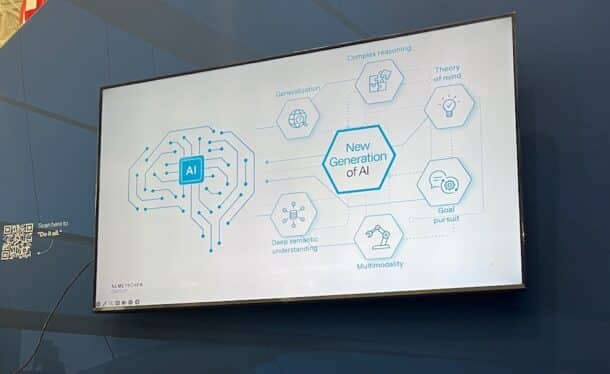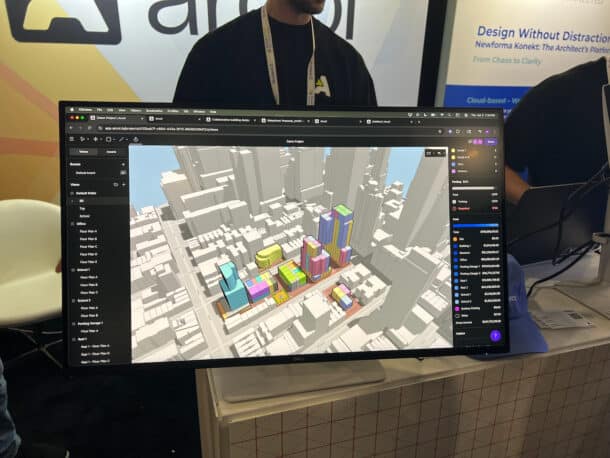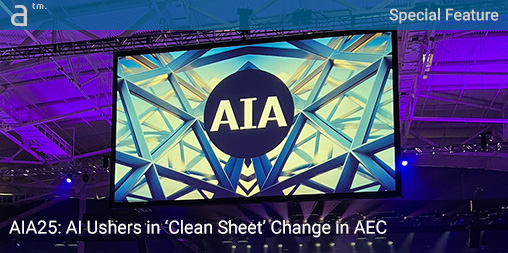PETE BUTTIGIEG SAYS A ‘CLEAN SHEET’ WAY FORWARD IS BEING FORCED ON US, and he is not just talking about politics and life in the ‘new normal’ post-truth world. His message at AIA25 Boston was directed at the AEC industry in the age of data, an age where artificial intelligence (AI) and machine learning (ML) operating on verified and truthful data can transform human life substantially positively. However, misdirected, bent by the forces of political division, that same technology could cause harm and, at the very least, stymie architects and their efforts to improve the built environment for all.
The Importance of Truth
In the case of Buttigieg’s remark about moving forward, he stated that we are operating in a post-truth, politically divided world, and in this world, facts and objective truth matter even more. His comment “it’s really important that in the tug-of-war and the push-and-pull of politics, the fighting at least be over something that is actually real,” drew appreciative applause from the AIA audience, as he ended: “I always say if I’m going to get beat up over something, I at least want to get beat up over something that is true.”
I always say if I’m going to get beat up over something, I at least want to get beat up over something that is true.
Buttigieg’s comment addressed data, and especially open data, used to address real policy decision-making in urban and rural communities, but it hits hard truths when it comes to forward momentum in society on topics such as energy, climate, resilience, and artificial intelligence. All these topics overlap in both a political context and a digital technology and software applications context.
Technology Truths
The industry at this moment is coming to grips with a potential velocity of change it has never seen before. After more than a decade of settling into specific technology solutions and workflows, firms and architects are facing potential disruption, especially from artificial intelligence (AI). But not all firms are truly grasping the importance of this moment in history, and the vast majority are looking at their technology stack largely the same as in recent years, based on recent successes.

Pete Buttigieg’s keynote talk at AIA 2025 Boston highlighted notions of data, society, facts, and truth.
This phenomenon is not unique to AEC/O and it is similar to what is known in the equities investment community as “anchoring bias,” referring to the mistake investors make in holding specific equities in their portfolios too long, specifically because they were excellent performers in the recent past. That is exactly the place history is finding the AEC industry with its digital tools. New AI technologies are going to diffuse themselves into tools and workflows, and some of these disruptions will make older tools more or less special, while new tools will become must-have digital equipment potentially displacing older tools and certainly altering future workflows.
Selecting digital tool stacks in AEC firms is exactly like dropping an anchor, and there are few firms in the world that are like Boston’s CBT Architects, who maintain a structured approach to objectively re-evaluating their digital tool stack on a regular basis (more on the CBT+Nemetschek event in another article). The firm is a model architectural organization in the United States for its disciplined and methodological approach to digital practice, which includes structured evaluations of a constant stream of new digital tools, many with AI overtones.
But the hard truth about digital technology change in AEC isn’t just about AI and machine learning. AI largely joins a chorus of ‘change vectors’ impacting or disrupting common assumptions about the evolution of BIM (Building Information Modeling). So AI is just one vector of three we see as critical.
MORE: Autodesk Begins New Era for Future of Architecture
These three change vectors we see as critical include, firstly, AI (artificial intelligence), secondly, the emergence of BIM 2.0 tools that for the most part are addressing the front-end of the design process and pre-design, and thirdly, from the maturing state of BIM itself (which correlates with many things including how desktop era tools can make the leap to cloud-era tools, how tools built for one OS and one microchip architecture can make the leap to multi-platform architectures, and how BIM authoring platforms interrelate to digital twins and the group of BIM 2.0 tools.)
One: Artificial Intelligence
AI is by far the most disruptive technology on the horizon. It is both here in early forms and out on the horizon in vastly more powerful and disruptive forms. Inside the Nemetschek Group booth at AIA Boston we heard from Julian Geiger, VP Head of AI at the Nemetschek Group, about all the aspects of a new generation of artificial intelligence, including AI agents that can do complex reasoning and agent to agent interactions. (see, Architosh: “Nemetschek Begins 2025 Strong — Tech Trends and AI Assistant,” 3 Feb 2025)

Julian Geiger, VP and head of AI at Nemetschek Group gave an interesting talk on where AI is going in the AEC industry.
Geiger referenced the important fact that 41 percent of AEC workers will retire by 2031. When hearing that the first thought that comes to mind is knowledge drain, but here AI tools may become a big part of the knowledge retention and diffusion story. The other pressing aspect of this retiring percentage is human-power. Who will replace these exiting workers?
Looking at the slide shown (above) from the Nemetschek booth talk, the use of AI multimodality work change may enable the smaller remaining human workforce in AEC to do much more than they could in the pre-AI era. The overall takeaway point by the Geiger talk is that AI in AEC is much more than just a visualization or image-generator. AI technologies will penetrate our existing tools and make them more productive for us, while helping to create entirely new software stacks.
And with this landscape of changing digital tools—and a large swath of new AI tools—the architectural professional and firm should learn to become systematically and critically evaluative. New tools are popping up all around us, especially those targeting the pre-design and early design phases where traditional BIM solutions are weak.
Two: BIM 2.0
BIM 2.0 technologies are recognized as the next evolution of BIM, moving away from foundational capabilities in BIM (eg: automatic drawings from 3D models) to more advanced capabilities grounded in new larger technology foundations. Whereas BIM 1.0 technologies were individualistic and bound to file-based desktop computing, BIM 2.0 technologies are built around real-time collaboration and are API-based cloud- computing.
BIM 2.0 technologies also address new advanced technologies such as machine-learning (ML) and AI, as well as simulation and computationally intensive integrations. However, the central defining difference is that BIM 2.0 technologies are cloud-native and run through either modern web browsers or in-app web windows or lean-clients with a mixture of cloud and edge compute resources being tapped to run the software. Arcol was at AIA25 Boston and they were one of the highlight digital technology booths at the show with a compelling first version available to the profession (more on Arcol in another report).

Arcol is one of the most exciting new BIM 2.0 tools and meets all the essential criteria of a BIM 2.0 tool. The cloud-first, mulit-user, early-stage BIM solution runs in a modern browser and helps architects and planners evaluate site and plan buildings faster, among many other key features including various analyses including cost.
The growing list of BIM 2.0 solutions shown at AIA25 Boston is noteworthy in progress and precision of focus to pain-points in the existing workflows led by traditional BIM software. We will dive deep into these solutions in our upcoming AIA25 Boston reports.
Three: BIM Unmet
When it comes to Building Information Modeling (BIM) as a process the process itself presents itself in two forms. There is “closed BIM” and there is “open BIM.” The leader of the closed BIM world is Autodesk with its ubiquitous Revit platform and strong third-party ecosystem. Then there is everybody else in the industry with their open BIM mantra and approach and largely led by global giant Nemetschek Group.
So let’s discuss briefly the unmet promises of BIM by attacking the most obvious issue first.
BIM promised us automatic drawings from 3D models and better design than 2D CAD processes. The problem is tools like Revit cannot easily or at all allow for the complete design modeling flexibility architects actually want and need. BIM tools are neither easy and fast for early conceptual design nor robust enough for complex formal exploration. Hence, the world’s most famous formalist architect of the past 50 years, Frank Gehry, famously created their own technology stack from the bones of CATIA. For all others who could not take that path, Rhinoceros and Grasshopper largely met the unmet needs of BIM with much more capable 3D modeling. And at the opposite side of the spectrum Trimble’s SketchUp helps architects and architectural students quickly formulate design concepts in 3D without the unneeded baggage of thinking of architecture in terms of BIM object types and creating objects through complex dialog boxes.
All of this can be broken down by saying that the parametric nature of 3D modeling in BIM comes with serious limitations that Sketchup, Rhino and Grasshopper address at various levels of freedom and computation capacity. And it is not just Revit that bears this limitation, all of its BIM authoring competitors for the most part suffer the same kind of limitation. Fluid and easy design modeling — and by saying “easy” I mean very flat learning curve — really largely remains in one vendor’s solution and that is Trimble’s SketchUp with its massive ecosystem of add-ons and library of objects. What the BIMs should be doing is robustly partnering with Trimble rather than aimlessly trying to compete with them or stymie their efforts.
And finally, another problem with the maturing BIM landscape is that these tools are technology-constrained. Autodesk Revit (and Bentley’s solutions too) is technology-constrained to Microsoft Windows and specifically the version bound to X86 chip architecture from AMD and struggling Intel. And all of the exiting BIM solutions are technology constrained to the desktop paradigm.
The future winner in BIM will not be limited and bound by these 1990’s technology constraints. And the present leader (Revit) has always told us that addressing the constraint around Windows was mostly about the large lift required to recode the BIM platform for multi-operating systems and chip architectures. This excuse is growing weak as Apple’s chips continue to put distance between them and the rest of the field (honestly, leaving the X86 field in the dust) and countless large tech companies speak of using AI automation rather than humans to produce millions of lines of code.
Closing Comments
As we review the digital technologies shown at AIA Boston 2025, we will pay special attention to these technology truths as they offer the AEC industry at large a new clean sheet approach to solving problems that traditional technologies today cannot. Stay with us over the next days and weeks as we unpack a large roster of interesting digital technologies and solutions.



